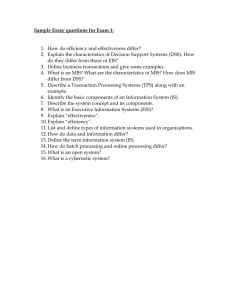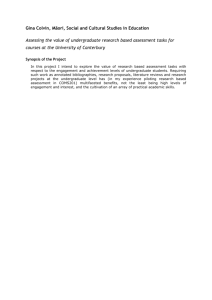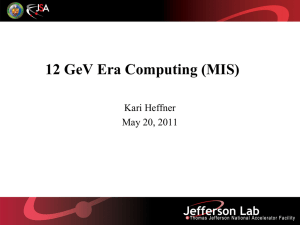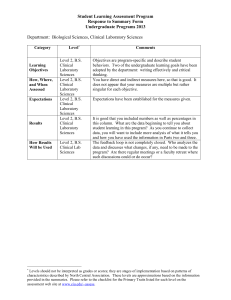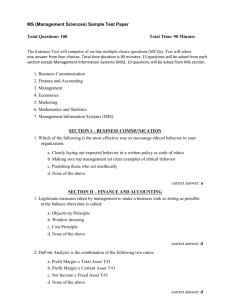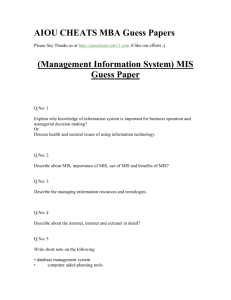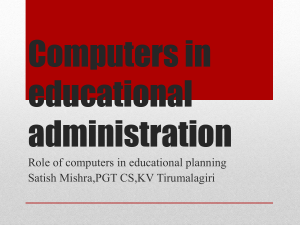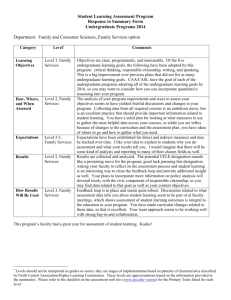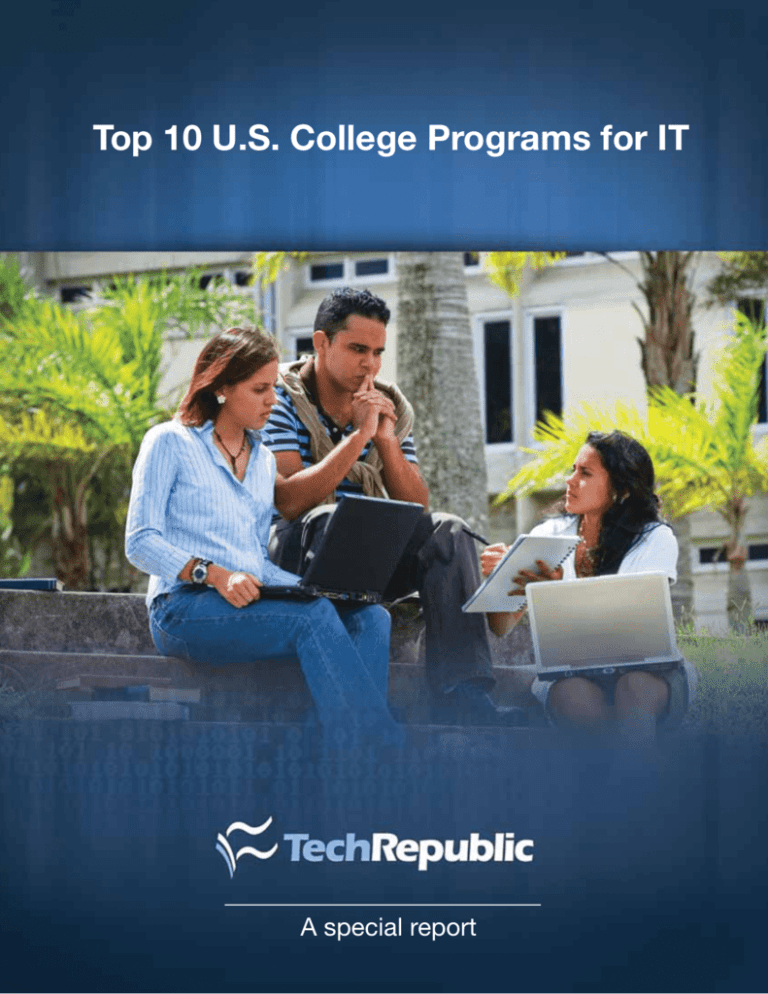
Top 10 U.S. College Programs for IT
A special report
Introduction
3
Methodology
4
Brigham Young University
5
Carnegie Mellon University
7
James Madison University
9
Massachusetts Institute of Technology
11
Pennsylvania State University
13
Temple University
15
University of Arizona
17
University of Illinois at Urbana-Champaign
19
University of Maryland
21
Virginia Tech
23
Survey results: Educational background
of working IT pros
25
Directory of other IS/IT undergraduate
programs in the United States
30
Introduction
W
hen I first arrived at college, I heard about a career
Since we at TechRepublic think these
track for people who managed and supported
programs will give future IT leaders a
networks of computers. At the time, these were
great foundation and a big step forward,
referred to as Systems Analysts or MIS professionals. There were
we decided to embark on this special
even hints of a new field called information technology that was
report to help identify the best college
emerging. What a great job that would be, I remember thinking at
IT programs in the United States. Our
the time.
Education Committee pored over information from lots of different colleges and
So I started looking for computer classes that I could take to
minor (or even possibly major) in a computer-related field. Unfor-
Jason Hiner
universities and ultimately came up with
Editor in Chief,
this list of 10 “can’t miss” programs.
TechRepublic
tunately, nearly all of the computer classes I found at my public
university involved programming UNIX systems and mainframes.
You should note that we have focused on IT business education
Since I wasn’t really interested in programming, my dreams of
rather than computer science, which is aimed at programmers
becoming a professional computer geek appeared to be dashed.
and developers. We feel that the two are different tracks, although those who are interested in managing teams of develop-
However, through a combination of luck and persistence, I did
ers and getting on the CTO career track could certainly combine
end up going into IT after I graduated from college with a liberal
the two in a major/minor scenario.
arts degree. I got some formal technical education through
professional training courses, and I ended up getting a couple of
That said, we chose to focus this special report on the CIO career
technical certifications to show that I at least had some minimal
track, which includes IT professional roles such as support pro-
competency in IT.
fessional, network administrator, project manager, IT consultant,
and IT manager. For that crowd, a strong foundation in business
But in the five years after I left college in the mid-1990s, the IT
administration is just as important as a good technical education.
field exploded. Lots of new workers poured into IT, and like me,
most of them did not have a formal education in IT management.
While we realize that all of these kinds of lists are highly subjec-
However, since then, colleges and universities have begun to
tive, we are confident that the 10 programs we identified all
catch up. Some now have entire schools dedicated to IT, while
provide a superior education in the business of IT. We chose not
many others offer bachelor’s degrees in Information Systems,
to rank by number, since that gets even more subjective. The bot-
Information Technology, Computer Information Systems, and
tom line is that you can’t go wrong with any of these programs.
Business Information Systems.
A degree from one of these 10 programs will provide a great
foundation for a successful IT career.
When I look at the curriculum of any of these programs, I am
intensely jealous. Most of them include a great mix of founda-
And, while we primarily view this report as a service that we can
tional business and technology knowledge that would have been
offer to the next generation of aspiring IT leaders, current CIOs
invaluable for me when I was getting started in IT. I had to learn
and IT managers should also use it as a way to find the colleges
most of that stuff the hard way -- by making mistakes, going
and universities that are producing some of the best IT talent on
with my gut reaction, and simply trying to apply common sense
the planet.
principles.
Jason Hiner
Editor in Chief, TechRepublic
October 2008
3
Methodology
W
hen selecting our list of 10 undergraduate IS/IT
Percentage of faculty with Ph.D.
programs to feature in this TechRepublic Special
Placement (i.e., percentage of students who landed a job
Report, we tried to assess which programs would
within six months of graduation)
offer the most value to students who wanted to work in the busi-
Co-ops and/or internships offered in the program
ness end of IT. Our Education Committee considered the follow-
Number of computer labs
ing criteria:
Overall “strength” of the program
Curriculum of the IS/IT program (We decided that the
classes should be geared toward business rather than
Caveat: Some schools were not considered based on our lack of
engineering for this Special Report. This means that any
information about their programs. Sometimes this was due to us
Computer Science degrees were not considered.)
not getting responses to our queries in time for publication of this
Cost value analysis for the education
report, or because we were unable to find the pertinent information on the school’s Web site.
Student/faculty ratio
4
Brigham Young University
W
ith 26,000 students arriving from all 50 states and
more than110 countries, Brigham Young University
(BYU) is the nation’s largest religious university.
Established in 1875, the campus is situated in the heart of Provo,
Utah, and in the shadow of the Wasatch Mountains, giving
students immediate access to suburban amenities and natural
wonder.
A private university linked with the Church of Jesus Christ of
Latter-Day Saints (LDS), BYU routinely ranks among the nation’s
most affordable private schools. Touted as some of the nation’s
“happiest students,” many of the university’s LDS students enter
their final years of study following a two-year mission trip, thereby
affording BYU a more mature, sophisticated campus feel than
most.
Upon applying to the university, all prospective students sign
an honor code that governs such issues as chastity, dress, and
alcohol, a sign of the campus’ conservative cultural and social
atmosphere.
Sitting amid the mountains of Provo, Utah, BYU students
inhabit a picturesque campus.
A hotbed for IS graduates
Romney said. “Beyond that though, it’s the hands-on practice we
Minus the flash of Silicon Valley and the aura of Ivy Leaguers,
provide our students. Our students certainly get plenty of theory,
BYU has nevertheless delivered a cutting-edge IS curriculum that
but we consistently challenge them to apply that theory to real-
consistently produces some of the nation’s most sought-after
world situations.”
graduates.
The unique structure of the IS program, which earns students a
One of the most celebrated -- and youngest -- IS programs in the
B.S. in Information Systems/Information Technology under the di-
country, BYU’s IS department didn’t start standing on its own feet
rection of the university’s lauded Marriott School of Management,
until the 1990s. However, the program has quickly emerged as a
distinguishes BYU from some of its chief rivals. To enter the
destination spot for some of the world’s most eager IS students.
program, students must fulfill two years of prerequisites, includ-
This is largely a result of top-notch faculty (all faculty hires in
ing a variety of courses with a strong business focus. Romney is
the last 12 years have arrived from elite Ph.D. programs), the
quick to note the competitiveness of the program: It takes a 3.6
success of its graduates (100 percent find a job in the field within
GPA or above to get into BYU, and then a 3.5 at the university to
six months of graduation), and the hands-on curriculum that
gain entry into the IS program in a student’s junior year.
challenges students with real-world scenarios and business best
“Simple supply and demand gets us some of the nation’s top
practices.
students and some phenomenal raw material,” Romney said.
“The integrative nature of what we do really sets us apart; our
Once in the IS program, all students endure two consecutive
professors are constantly communicating and trying to bring the
12-hour semesters in which teachers rotate out of the classroom
different courses together,” IS Department Chairman Dr. Marshall
5
their study into a real-world context,” Dr. Romney said.
The second semester of year one follows a rubric much like the
first: academic work mixed with practical application. Students
take a class in Data Communications, while a Systems Design
and Implementation class works side-by-side with a course in
Enterprise Application Development. The final three-hour course
derives from a semester-long project in which students return to
the case they analyzed in the first semester. Handed blank computers, students are then challenged to design and implement a
completely operational system by semester’s end.
As their final year approaches, students decide to follow one of
In one of the department’s many opportunities for current students to
mingle with career professionals, BYU students join with Ernst & Young
staff members to complete a teambuilding exercise.
two tracks. One-third of the program’s 120 students earn admission into the master’s degree path. In their remaining two years
while students stay put. In the first semester, students face four
on campus, those 40 students will take a core of M.B.A. classes
three-hour courses: Systems Analysis, Database, Business Pro-
alongside more intensive IS classes. The other 80 students
gramming, and Business Controls. The program’s 120 students
complete their undergraduate work with a curriculum heavy in
share 13 faculty members, affording students quality access to
business, including courses in Ethics, Economics, and Marketing.
instructors.
Jason Hessing, a 2002 graduate who went on to earn a master’s
The first semester concludes with a one-week integrated exer-
degree at Indiana University before landing a job in the IT depart-
cise, a central example of the program’s hands-on mission. On
ment of national grocer SUPERVALU, says the rigorous academic
Monday of the final week, students encounter a past case from a
work he faced at BYU prepped him for the professional world.
professional firm and perform the business analysis, coding, and
“BYU put me ahead of the curve in key areas because we didn’t
design -- a mock up of the entire system. On Friday, students
just learn about IT, we did it,” Hessing said. “The education
hand in their written presentation, while an oral presentation
helped me develop two different skill sets: the business acumen
is presented to a group of career professionals and faculty on
to understand the corporate world and th necessary understand-
Saturday morning.
ing and language I needed to address the technical folk on a
“The opening four classes walk students through the standard
given project.”
systems they’ll see in the working world and then turns in that
Daniel Smith
final week to practical, active learning in which they have to put
Key Information
Address: A-209 ASB Provo, UT 84602
Undergraduate student body: 26,910
Phone number: 801.422.2507
Percentage of students who live on campus: 20%
Fall 2009 admissions deadline: March 30, 2009
Tuition (per year) 2008-2009: $15,330 (LDS), $19,410 (non
LDS)
Admissions e-mail: admissions@byu.edu
Setting: Urban
6
Carnegie Mellon University
C
arnegie Mellon University was founded in 1900 by
Degree requirements for a B.S.B.A. are a minimum of 364 units.
Andrew Carnegie as a philanthropic gesture to spread
Freshman and sophomore years’ coursework include topics
knowledge to all people. Located in Pittsburgh, PA,
you would expect such as economics, accounting, and statis-
Carnegie Mellon University celebrates the area’s Scottish roots
tics, as well as computing and programming. Junior and senior
while achieving academic excellence. The sound of bagpipes,
years are when students take track courses. The four required
the bark of Scottish Terrier dogs, and the distinct look of Tartan
courses for the Computing and Information Technology track
plaids tell the venturer that he has entered a unique campus
are: Data Structures, Systems Analysis and Design, Information
environment. Carnegie Mellon is also one of the leading technol-
Resources Management, and Telecommunications and Network
ogy universities in the world.
Management. Students must also take two of the other seven
courses offered, which include E-commerce Strategy, Information
Tepper School of Business
combines innovation with
analytical decision making
Technology Strategy, and Decision Analysis and Decision Support Systems. Tepper students also have to fulfill nine Breadth
Requirements; World History and Interpretation and Arguments
are the two breadth courses that are required. While it may sound
Carnegie Mellon University’s
Tepper School of Business
is a leader in cutting-edge
learning with a commitment
to knowledge discovery via
interdisciplinary collaboration. The school’s heralded
management science model
has been used in some
form in many other business
schools’ curriculum.
Tepper offers a Bachelor of
Science in Business Administration (B.S.B.A.) degree
with a specialized track in
Computing and Information
Technology. Tepper CIT
students can minor in Sup-
Carnegie Mellon University is located in Pittsburgh, Pennsylvania.
ply Chain Management or
Business Administration. Executive Director of the Undergraduate
rigorous, there are many course options available to students
Business Administration program Dr. Milton L. Cofield notes that,
within each category, allowing each student to customize his or
“Historically, the Computing and Information Technology program
her educational experience so that it will best serve the student in
has been a track that has generated the most interest at Tepper,
the future.
particularly during the Bubble period.”
7
“
Historically, the Computing and Information
Technology program has been a track that has
generated the most interest at Tepper.
”
Tepper students partner with faculty, researchers, and students
from other departments and schools, providing tech students
with a well-rounded education. Dr. Cofield believes this is one of
the primary assets of the program. “Tepper students in the Computing and Information Technology track benefit from being in a
university that values computing. With the strong technical focus
in the Computer Science Department, the Information Systems
program in the College of Humanities & Social Sciences, and the
College of Engineering, students interested in this field can be as
technologically focused as they want to be.”
Each year, more than 400 companies go to Tepper to recruit
undergraduate business students. Dr. Cofield noted that approximately 30-50 percent of the companies are recruiting for students
with an IT education. “Many graduates of the Computing and
Information Technology track go into consulting or work for
software development or implementation companies. Other core
groups go into mainstream manufacturing, logistics, and supply
chain management.”
The Tepper School of Business has one of the best student/faculty ratios
of any top-tier school.
Nicole Bremer Nash and Mary Weilage
Key Information
Address: 5000 Forbes Avenue Pittsburgh, PA 15213-3890
Setting: Urban
Phone number: 412.268.2000
Undergraduate student body: 5200
Fall 2009 admissions deadlines: January 1, 2009 (regular)
and September 1, 2009 (early, pre-school attendance)
Percentage of students who live on campus: Freshman
required
Admissions e-mail: undergraduate-admissions@andrew.
cmu.edu
Tuition (per year) 2008-2009: $39,150 (resident and nonresident)
8
James Madison University
J
ames Madison University (JMU) students inhabit a
sophomore year, provides students with an insightful look into
century-old campus positioned in Virginia’s historic and
what IS professionals do as well as the industry’s present state
scenic Shenandoah Valley. Once an all-girls’ college (men
and potential evolution.
began enrolling in 1946), JMU now hosts 18,000 public college
“The class focuses on the likely roles that business professionals
co-eds — over 16,000 of them undergraduates — studying more
will have in regard to information systems: end-user, manager,
than 100 degree programs. In recent years, the university has exand innovator,” said CIS Department Chairman Dr. Richard
panded — both physically and academically — building a second
Mathieu. “In order to accomplish these goals, the hands-on
library, breaking ground on a performing arts center, purchasing
component of the class focuses on collaboration and workflow.”
the former Harrisburg High and nearby Rockingham Memorial
Hospital for added space, and adding the School of Engineering
After gaining admittance to the College of Business, a CIS stu-
in 2007. The Princeton Review and Money Magazine have both
dent’s junior campaign begins with a 12-credit integrated course
recognized JMU as one of the nation’s best college values.
in which students create a business plan. Then comes “the meat
of the program,” said Mathieu, as students are challenged with
Building an IS program to rival
any of the nation’s finest
a modern curriculum heavy in experiential work and applied
science. Students take required courses in such IT program
stalwarts as database and systems analysis and design while
One of only a handful of undergraduate programs in the country
adding a lengthy list of compelling elective courses: business
with both ABET and AACSB accreditation, JMU’s Computer
process management, Web development, computer forensics,
Information Systems (CIS) program blends a sound business
and security.
education with a curriculum that does not back off the technical content. Alongside the College of Business’ core staples
(integrated curriculum, business
plan, interpersonal skills, and
project orientation), the CIS
program -- which earns students
a B.B.A. (Bachelor of Business
Administration) in CIS -- maintains
the fundamental technical skills
necessary for a successful career
in the IT field.
The CIS program, which hosts
approximately 200 degree-seeking
students alongside 100 looking
to earn an IS minor, begins with
a freshman and sophomore year
track that is heavy in business.
An Introduction to IS class,
taken during one’s freshman or
Located in Harrisburg, VA, the James Madison University campus hosts
approximately 18,000 students.
9
“
We feel like the secret to our success has been our ability to maintain the fundamentals
while mixing in innovative electives.
”
measurable head start. “By the time I had graduated, I had gone
through an entire systems development life cycle, so nothing was
a surprise to me when I entered the consulting world. I had done
the hands-on work to create that mock project from the ground
up and was a few months ahead of my peers because of that
experience,” said Bouchoux, who in 2008 was hailed by Consulting Magazine as one of the top 30 consultants under 30.
Dr. Richard Mathieu heads James Madison University’s IS program.
A CIS executive board comprised of partners in area firms works
“We feel like the secret to our success has been our ability to
with the faculty to make certain that the program’s objectives and
maintain the fundamentals while mixing in innovative electives,”
outcomes remain relevant to real-world needs. And the JMU pro-
Mathieu said.
gram’s results speak for themselves: 92 percent of students have
work experience before they graduate, many landing competitive
One elective, in particular, has been a roaring success with stu-
internships in and around the D.C. area; 85 percent of students
dents and highlights the program’s success in responding to --
are hired before graduation; and a full 100 percent have employ-
and preparing for -- an ever-changing industry. At the suggestion
ment in the field within six months after graduation, many landing
of its alums, JMU added an IT Consulting course to its elective
at marquee companies such as IBM, Accenture, and Ernst &
list in 1999. In the semester-long course, teams are assigned to
Young.
professional consulting firms and work with those mentor firms
to complete a project covering each phase of the consulting life
“Those numbers,” Mathieu said, “show that we’ve made the
cycle.
academic environment relevant to both our students and the
industry. Our faculty is focused on undergraduate education like a
Meaghan Bouchoux, a 2000 JMU grad now working as a
laser beam.”
manager with Bearing Point, took the course during her tenure at
the school and credits it with giving her consulting career an im-
Daniel Smith
Key Information
Address: 800 S. Main St. Harrisonburg, VA 22807
Undergraduate student body: 16,089
Phone number: 540.568.6211
Percentage of students who live on campus: 30-35%
Fall 2009 admissions deadline: November 1, 2008
Tuition (per year) 2008-2009: $6,964 (resident), $9,229
(nonresident)
Admissions e-mail: admissions@jmu.edu
Setting: Urban
10
Massachusetts Institute of Technology
A
gainst the vibrant backdrop of the cities of Boston and
focuses on the creation and implementation of complex systems.
Cambridge, the Massachusetts Institute of Technology
The S.B. (Bachelor of Science) in Management Science degree
(MIT) campus buzzes and pulses with an energy all its
is interdisciplinary, combining courses in computer program-
own. MIT students learn from contemporary problem solving, and
ming, logic, analysis, communications, and psychology, just to
projects often involve searching for solutions for today’s industrial
name a few. The idea is that students learn everything about
and technologically-based problems. The fact that MIT is not only
how companies work, including how to anticipate employees’
a land-grant university,
but also a sea-grant and
space-grant university is
proof that MIT students
are honored with opportunities to solve tomorrow’s
problems today.
One of the most outstanding things about the MIT
experience is that it is inherently crossdisciplinary.
Students enter MIT as
one cohesive freshman
class. They do not declare
majors until the end of the
freshman year, allowing
students time to explore
different areas of interest before committing to
their majors. Even after a
MIT was founded by William Barton Rogers in 1861 as a result of the Industrial Revolution.
student enters a specific
program, like the Sloan School of Management, they continue to
actions and reactions. Some of the top fields that graduates work
receive interdisciplinary educations, taking courses in everything
in are Information Technology and Financial Services. The Sloan
that MIT offers and interacting with faculty in all departments. The
experience corresponds with that by working closely with China’s
faculty also enjoy the interdisciplinary experience themselves.
Tsinghua University School of Economics and Management.
Cutting-edge education
in Management Science
Students learn how to tackle the multifaceted problems faced in
The Sloan School of Management’s S.B. in Management Science
and forward thinking, students find themselves inherently excited
undergraduate program teaches students advanced, complex
about new ideas and are often found problem-solving during their
problem solving skills for business leadership. This degree
social interactions.
today’s business world and how to plan for businesses of the future. Combined with a “no-boundaries” attitude toward invention
11
MIT Sloan students learn complex problem solving skills.
Director of Sloan Undergraduate Programs and Senior Lecturer,
The general institute requirements also necessitate eight courses
Jeff Meldman, Ph.D., attributes much of the school’s success to
in humanities, the arts, and social sciences. In addition to the
the students. “One of the best things about MIT is the students
general institute requirements, Sloan Management students
-- they are extremely bright and enthusiastic.” As always, enthu-
must also complete 123 units (credit hours) in required subjects
siasm is contagious. Dr. Meldman continues, “The students and
such as Statistical Thinking and Data Analysis. Top those off
faculty act as role models for each other, which is exciting and
with another 36 to 48 units taken in restricted electives, such as
keeps us all fully engaged.”
Finance Theory, and there is no doubt that students receiving the
S.B. in Management Science degree from the MIT Sloan School
Degree requirements for the S.B. in Management Science include
general institute requirements like calculus, physics, chemistry,
of Management are ready to excel in the business world of today
and lead the business world of tomorrow.
and biology. Two science- and technology-restricted electives
must also be completed, as well as one laboratory requirement.
Nicole Bremer Nash
Key Information
Address: 77 Massachusetts Avenue Cambridge, MA
02139-4307
Setting: Urban
Undergraduate student body: 4,172
Phone number: 617.253.1000
Percentage of students who live on campus: 70%
Fall 2009 admissions deadline: November 1, 2008
Admissions e-mail: admissions@mit.edu
Tuition (per year) 2007-2008: $34,986 (resident and nonresident)
12
Pennsylvania State University
P
ennsylvania State University is nestled among rolling
For students who want to become entrepreneurs and create their
mountains in State College, PA. This peaceful town,
own successful businesses, classes in enterprise resource plan-
which is the country’s least stressful city to live and
ning, database systems, and Internet technology use are funda-
work in, according to Psychology Today, is the perfect backdrop
mental. Hands-on experience with business software systems
for students who are studying hard.
is a crucial element of the MIS degree, as are problem-solving
workshops with real-world businesses. Courses in system design
Penn State excels at giving students an education and undergraduate experience that will help them grow into industry
leaders. Working closely with businesses and agencies outside
and algorithmic programming give students the technical knowledge and experience to become integral parts of any company’s
technology solutions team.
the university gives students real-world experience from inside
the classroom, and abundant internships allow students to get
Another Smeal program that pairs well with the MIS major is the
workplace experience while still in school. Dedicated faculty and
B.S. in Supply Chain and Information Systems. Many students
specialized degrees offer students an unrivaled college experi-
double-major in the two, giving them a competitive edge in the
ence.
world of business technology. The Supply Chain and Information Systems curriculum focuses on the technology needed to
Smeal College of Business
teaches personal and
business excellence
Of Penn State’s 35,000+ undergraduate students, less than 5,000
control and track the movement of goods between manufacturers
and suppliers. Beginning with fundamental business processes,
such as manufacturing and distribution, students follow business
models through to the design and maintenance of supply chains
and supply chain technologies.
are enrolled at the Smeal College of Business. Smeal students
learn from expert faculty and enjoy
courses that are designed to teach
them the skills and knowledge they
need to meet their individual goals.
Core values of integrity and honor
are fundamental at Smeal, and
students and faculty work together
to ensure that everybody adheres
to these values.
One program that draws students
to the Smeal College of Business is
the B.S. in Management Information Systems degree program. The
Management Information Systems
(MIS) program teaches students
how to select, implement, and use
technology in the business world.
Smeal students learn from expert faculty
13
“
Companies recruit our graduates because they are well-educated,
highly motivated, and experienced.
”
Assistant Department Head and Instructor of Supply Chain
Management, Professor Norman Aggon attributes much of
the program’s success to the students themselves. “We have
high-caliber, well-motivated students,” says Professor Aggon.
Motivated students want to learn, and Smeal offers opportunities of all sorts. Smeal’s Office of Career and Corporate Services
internships and co-op opportunities give students the experience
and knowledge necessary to obtain high-level jobs.
The Department has its own Career Placement service that supports nearly 200 companies per year that recruit supply chain and
information system and MIS graduates. Additionally, the Center
for Supply Chain Research sponsors a two-day Supply Chain
Career Fair twice a year, which connects students with approximately 90 employers. “Companies recruit our graduates because
they are well-educated, highly motivated, and experienced,”
explains Professor Aggon.
Employers also know that Smeal’s Supply Chain and Information Systems program uses the Supply-Chain Council approved
SCOR(r) model. This means that the Department’s curriculum
is industry driven, giving students a competitive edge in the job
market.
Professor Norman Aggon, Assistant Department Head and Instructor of
Supply Chain Management, in the classroom.
Nicole Bremer Nash
Key Information
Address: 201 Old Main University Park, PA 16802
Undergraduate student body: 35,447 (main campus)
Phone number: 814.865.5471
Percentage of students who live on campus: 40%
Fall 2009 admissions deadline: November 30, 2008
Tuition (per year) 2008-2009: $14,226 (resident), $26,020
(nonresident)
Admissions e-mail: admissions@psu.edu
Setting: Urban
14
Temple University
L
ocated in Philadelphia, PA, Temple University teaches
students more than just academics -- students gain
experience and personal character development through
Temple’s many volunteer programs.
Temple boasts its own Habitat for Humanity chapter, in which
students, faculty, and staff alike work to educate the greater community about poverty and housing deficiencies, and help Habitat
for Humanity build houses for people in need. Temple students
also gain hands-on, real-world experience through Temple’s
community outreach programs like the Diabetes Center for Excellence.
Fox School of Business
prepares MIS students for
the real world
Temple University’s Fox School of Business offers academic
programs that lead to real-world success. Fox’s Bachelor of Business Administration (BBA) in Management Information Systems
(MIS) full-time program is one that students do not begin until
either their sophomore or junior year. As a foundation of the
B.B.A. MIS program, students learn how to recognize problems
that businesses face and evaluate those problems for ways in
which technology can help. They also learn how to evaluate
The Temple community also helps students grow into world leaders and
stewards by encouraging philanthropic community involvement.
new technologies for business applications. On the computerprogramming side, many students learn how to create and write
the best possible computer programs to resolve business needs.
In addition, students gain real-world experience in communicating with management and technical staff.
The B.B.A. MIS program requires that students complete interactive case studies, as well as hands-on projects using cuttingedge technologies. Alumnus Anthony Bubel, whose current
job title is “Happiness Engineer” (he’s a Support Engineer) for
By the second semester in the B.B.A. MIS program, students are
Attomattic, the company behind the blog-publishing platform
already learning how to develop technical applications for busi-
WordPress, says the cornerstone of his undergraduate education
nesses. Mandatory courses for the B.B.A. MIS include Business
was an independent study project. Bubel says, “The department
Process Analysis, Managing Global Information Systems, and
really supported us through the entire project. Presenting to the
at least one elective. Elective courses include Secrets of Web
Executive Advisory Board was a great payoff to our work.”
Marketing and Strategic Management of IT. Students may also
complete an Independent Study or a Co-Op Experience to round
out their education.
The Institute for Business and Information Technology’s Executive Advisory Board is very invested in the work that the students
do. Advisory Board Chair Bruce Fadem says that working with
15
“
[The BBA MIS program] makes our graduates recession proof by
teaching them higher-order skills that cannot be easily outsourced.
”
the students is one of the best experiences of being an Advisory
Nearly 100 percent of MIS graduates already have jobs lined up
Board member. “We are amazed at the imagination, creativ-
at graduation, which is a real testimony to the program’s excel-
ity, and the ability to successfully obtain project goals that the
lence. Companies hire individuals with B.B.A. MIS degrees for
students regularly present,” affirms Fadem. The Advisory Board is
positions such as project managers and business analysts.
deeply engaged in curriculum enhancement as well.
The faculty is also deeply engaged with students. Bubel at“We have a very strong relationship with industry,” explains
tributes much of his undergraduate success to the department
Executive Director for the Institute for Business and Informa-
members. “The faculty is so unbelievably distinguished and is so
tion Technology, and Associate Professor, Munir Mandviwalla,
willing to help with student development, from academics to pro-
Ph.D. “Our Institute for Business and Information Technology
fessional development and even personal development.” Bubel
has a membership structure that allows sustained interaction
tells current students that “getting engaged with, and to really
with industry. This ensures that our program focuses on learning
know the faculty will help you tremendously. They are a resource
outcomes that industry leaders look for when hiring.”
not to be ignored.”
Dr. Mandviwalla is a founding chairperson of the B.B.A. MIS
The MIS academic experience is bolstered by the Fox School’s
program and is proud to be part of a program that “makes our
Association of Management Information Systems (AIMS). This
graduates recession proof by teaching them higher-order skills
professional organization is comprised of students in the MIS
that cannot be easily outsourced.” All of the B.B.A. MIS courses
program. The group offers students a support community with
follow the theme of integration, including integration of systems
benefits such as tutoring, as well as a professional community,
and integration of business processes. Dr. Mandviwalla attributes
with programs involving guest speakers and practice exercises.
much of the program’s success to “faculty who work on innova-
A student enrolling in the B.B.A. MIS program will do well to
tive and relevant research that allows them to remain deeply
connect with and join AIMS. It offers a competitive edge to the
engaged with our industry members.” This engagement with
degree program.
industry helps faculty ensure that the skills students are learning
Nicole Bremer Nash
will lead to long-lived careers.
Key Information
Address: 1801 N. Broad Street, Philadelphia, PA 19122
Undergraduate student body: 22,306
Phone number: 215.204.7000
Percentage of students who live on campus: 79% (freshmen) / 20% (undergrads)
Fall 2009 admissions deadline: March 1, 2009
Admissions e-mail: tuadm@temple.edu
Setting: Urban
Tuition (per year) 2008-2009: $10,858 (resident), $19,878
(nonresident) * Tuition (per year) 2008-2009 for the Fox School
of Business and Management: $11,740 (resident), $21,494
(nonresident)
16
University of Arizona
L
ocated in Tucson, Arizona’s compelling natural beauty
Paulo Goes, Ph.D. “What they do best is translate the research
is the backdrop for the University of Arizona, one of
and experience to the classroom.”
America’s top research universities. From physics and
astronomy to cutting-edge medical training and research into
global warming using bristlecone pine trees, the University of
Arizona has come a long way from its beginning as a school with
little backing and direction.
The MIS program integrates knowledge of business technology
with the skills necessary to evaluate, administrate, and implement
appropriate and new technology. Students in the MIS program
not only learn how to evaluate and handle technology, but also
learn how to help people within an organization acclimate and
Eller offers specialized
degrees
understand new machines and software. Dr. Goes explains,
“What the students like best is learning how to apply the technology aspects to business solutions.”
Breaking ground in the world of business and management is
UA’s Eller College of Management. With a focus on integration,
research, and social responsibility, Eller students learn how to be
business managers in a fast-paced environment.
The four-year MIS program has students taking courses in the
field usually in the first semester of their freshman year. MIS
courses include Database Management Systems, Information
Systems Analysis and Design, Human Resource Information Sys-
Offering a Bachelor of Science in Business Administration
tems, and Models for Decision Support. The MIS program puts a
(B.S.B.A.), Eller’s Management Information Science (MIS) depart-
lot of emphasis on independent study and internship experience,
ment has been
teaching students
how to be industry
leaders and foresee technology
developments for
four decades. This
means that faculty
have experienced,
researched, and
been responsible
for developing and
teaching new technologies, and have
the background to
teach students to do
the same. “We have
great researchers,”
explains Salter Professor and Head of
the MIS department,
The University of Arizona is located amongst Tucson’s natural beauty.
17
Here is a photo of the MIS faculty from the fall 2007.
so students graduate with real-world, hands-on experience to
An MIS/OM double major necessitates only two additional course
prepare them for a fast-paced and complex industry.
requirements, giving students who are willing to go the extra mile
an enormous advantage over job competitors. The double major,
Many MIS students choose to combine study in the MIS program
combined with internship and independent study experience, enwith study in the Operations Management (OM) major to create a
sures that graduates have a full understanding and knowledge of
double major that expands their knowledge base and gives them
the issues that businesses face, and the most effective, efficient
an edge in the business world. OM concepts pertain to the use of
ways to apply technological solutions to industry problems.
effective, efficient technologies and methods, and can be applied
not only to manufacturing but also to service providers.
Note about the admission process: In order for students to declare an MIS, OM, or MIS/OM double-major, they must also apply
Areas of study for the four-year OM major include process imfor Professional Program Admission.
provement, linear programming, and quality control. OM majors
must also learn at least one computer programming language.
Nicole Bremer Nash
Key Information
Address: The University of Arizona Tucson AZ 85721
Undergraduate student body: 29,070
Phone number: 520.621.2211
Percentage of students who live on campus: 17% (freshman required beginning fall 2009)
Fall 2009 admissions deadline: May 1, 2009
Admissions e-mail: admissions@arizona.edu
Tuition (per year) 2008-2009: $5,550 (resident), $19,000
(nonresident)
Setting: Urban
18
University of Illinois at Urbana-Champaign
L
ocated approximately a two-hours drive south of Chi-
“It’s really a boutique program within the College of Business,”
cago in the sister cities of Champaign and Urbana, the
said Dr. Michael Shaw, Director of the Center for IT and
University of Illinois blends a Big Ten education with a
e-Business.
big-time IS program. Despite its relatively rural roots, the university is as technologically fast-paced as any of its urban counterparts. In fact, in 2008, PC Magazine named the University of
Illinois as the nation’s most wired college, specifically recognizing
the school’s high-tech academic offerings (such as data mining
Most students chasing the university’s B.S. in Information
Systems degree begin their college career with a steady dose
of traditional business classes, namely accounting, economics,
and operations. In their final semesters, students tackle a set of
IS-focused courses, such as Database Design and Management,
and parallel computing).
Systems Analysis and Design, and e-Business.
The University of Illinois has plenty
to offer students from the Land of
Lincoln and beyond. A lively campus,
the Champaign campus rarely lacks
action. Greek life is an integral piece
of the campus environment as are the
Fighting Illini athletic teams.
On the campus sits the National
Center for Supercomputing Applications (NCSA), which contributes
significantly to the global cyber infrastructure for science and engineering.
The NCSA’s reach has extended into
various industries such as medicine,
ecology, film, and music and includes
the 1993 creation of NCSA Mosaic,
a groundbreaking Web browser that
In the shadow the Illini Union, students travel through the campus quad to attend classes.
streamlined the Web experience.
The presence on campus of such a cutting-edge technological
“We’re a university known for our tech focus and [our IS program]
organization sets a high precedent for the university’s IS students
remains in close contact with those tech roots and yet exists in
to follow.
the business college to understand how the technology and busi-
An IS program that blends
business and IT acumen
ness can work hand-in-hand,” Shaw said.
As Shaw and his IS program colleagues see it, industry has
increasingly called for a blending of business and IT acumen.
Two decades ago, the Information Systems program was little
The program has worked to reflect that tech-business mix by
more than a specific concentration housed in the Department of
attempting to provide students skills in business analytics and
Business Administration. As the IT world evolved, however, so
business analysis, including systems analysis and project man-
too did the IS program, which now represents eight percent of all
agement. The University of Illinois program also offers a pair of
majors in the College of Business.
19
“
That mix of qualitative and quantitative learning is a fundamental strength of
the program and creates an environment
of learning, particularly with respect to
how IT fits into business.
”
“That mix of qualitative and quantitative learning is a fundamental strength of the program and creates an environment
of learning, particularly with respect to how IT fits into business,” said Miller, the founder, President, and COO of The
Revere Group, an IT consulting group based in Chicago that
now claims nine offices throughout the nation.
In October 2008, a pair of IT managers from Motorola visited the
Champaign campus to talk with students in the IS program.
Miller says he has seen first-hand how the IT program reaches
out to its alumni in an effort to be ahead of the industry curve.
specialized areas: IT Governance, as well as an in-depth look into
Shaw, in fact, turned to Miller just as businesses began investi-
the functions of a CIO.
gating Web 2.0 and social networking as business tools, looking
“IT is moving into these areas heavily and so we’re responding
specifically into how the school could work such features into the
with our curriculum,” Shaw said, speaking specifically of the
curriculum.
governance and CIO areas. “We’re working hard to be at the forefront of interesting information program development, so that our
students know how to use IT in a way that can enhance performance while achieving risk management and a good governance
function.”
One of the program’s defining characteristics remains its ties
with industry throughout the state. From internship opportunities
with Illinois-based companies such as Caterpillar and State Farm
to regular presentations by working CIOs, the program seeks to
expose its students to real-world conditions.
Todd Miller, a 1981 graduate of the university, says the IT program blends the quantitative and qualitative skill-building central
to the achievement of the school’s world-renowned engineering
program and has applied that rubric to the business world.
“We’re blessed to have those ties because it gives our student’s
added insight into the industry and, frankly, makes them attractive hires,” Shaw said.
Daniel Smith
Key Information
Address: 919 W Illinois St. Champaign, IL 61801
Setting: Urban
Phone number: 217.333.0302
Undergraduate student body: 32,895
Fall 2009 admissions deadline: November 1, 2008 (priority
filing) / January 2, 2009 (application filing)
Percentage of students who live on campus: 52%
Admissions e-mail: http://admissions.illinois.edu/contact_
us.aspx?name=Illinois%20Admissions&id=admissions
Tuition (per year) 2008-2009: $11,130 (resident), $25,216
(nonresident)
20
University of Maryland
A
major public research institution located in the
“We have faculty with experiences in a wide range of disciplines,
Baltimore-Washington, D.C. high-tech corridor, the
so there’s rarely something a student will encounter that one of
University of Maryland benefits from its region’s
our faculty won’t have experience in,” Lucas said.
constant momentum. The school has forged strong alliances with
the U.S. federal government, as well as a number of established
corporations in the greater D.C. area. The university’s status
as a research institution puts it on the cutting edge of evolving
On the technology front, the University of Maryland as a whole
places strong emphasis on understanding the tech world’s beat.
All students in the Smith School of Business take a Management
Issues in Technology course, which explores how technology
industries, including the IT field.
continues to transform businesses and daily life. As students
Preparing IS students to be
effective leaders
enter the IS program curriculum, they quickly encounter an introductory course that shows how information technology stands as
the driving force in today’s business world.
Graduates from the IS program earn a B.S. in Information Systems under the banner of the university’s Robert H. Smith School
of Business, a school often recognized as one of the nation’s top
“We’re eager to show students how technology has and will
continue to transform industries big and small,” Lucas said.
undergraduate business colleges, a fact evident when the school
While an IS student’s first year at the university follows a busi-
earned a top 20 ranking from U.S. News and World Report in
ness school curriculum, a student’s sophomore year begins to
2008. The IS degree program maintains a clear focus on prepar-
invite major courses. Like other accomplished IS programs, the
ing students to be effective planners, users, and managers of
core courses include instruction in database, programming, and
information systems, with technology and faculty contributing
systems analysis and design. Elective courses, meanwhile, cover
heavily to the program’s success.
As a research university, the IS program’s
faculty is filled with Ph.D. professors, who
double as industry experts on the front
line of the evolving field. Sixteen of the
program’s 17 faculty members hold a Ph.D.
(the lone faculty member that doesn’t hold a
Ph.D. brings corporate CIO experience) and
instruct classes containing 20-30 students.
The faculty’s research background comes
in handy as students encounter instructors
wise to the IT world’s evolution and working to create state-of-the-art material for
student use. Also having one of the nation’s
largest IS faculty groups gives the University
of Maryland a distinct advantage, says IS
Department Chairman and Professor Dr.
Henry Lucas.
The Testudo statue is a centerpiece of the campus. Students have been
rubbing his nose for good luck since 1933.
21
“The capstone course forces students to integrate their knowledge because the IT world, unlike the academic world, doesn’t
come neatly packaged in courses,” Lucas said.
The Robert H
H. Smith School of Business is one of nation’s most lauded
business colleges.
Though prospective 2009 grad Ann Squitieri has yet to encounter
the applicable challenge presented in the capstone course, she
such titles as project management, optimization, quality management, and telecommunications. Lucas describes the curriculum
as one grounded in real-world practice with an eye on the future.
nevertheless believes the IS program has done plenty to prepare
her for the impending rigors of professional life. During a 2008
internship with UPS, she encountered numerous concepts that
she recognized from previous classes and, most importantly, was
“We know that the key thing we need to do is help students
able to apply those concepts to a real-world business problem.
learn how to solve problems. Some of the facts they learn today
will change as the industry evolves, but if they can look at new
technology and know how to apply it, they’ll be positioned well
for career success,” Lucas said.
“I’m grateful for the education I’ve received and just how relevant it has already been,” Squitieri said. “My bosses and even
co-workers [at UPS] were impressed that they would present a
concept, and I was able to interpret it for them or explain it.”
A capstone project course creates teams of students tackling a
project for a local company. Incorporating the knowledge they’ve
gleaned from all of their IS courses, students work cooperatively
to develop a prototype system. The success of the capstone
course is clear: For those students who haven’t secured a
full-time employment offer following an internship, their work in
the capstone project typically leads to recruitment from major
Outside of the IS classroom, many of the program’s students join
the Business and Information Technology Society (BITS). Run by
a faculty advisor, BITS hosts corporate speakers and seeks to
expose students to the diverse range of career paths they can
pursue with their IS degree.
Daniel Smith
regional firms.
Key Information
Address: College Park, MD 20742-5025
Setting: Urban
Phone number: 301.405.1000
Undergraduate student body: 28,857
Fall 2009 admissions deadline: November 1, 2008 (Part I),
December 1, 2008 (Part II), January 20, 2009 (General Application, non-priority consideration)
Percentage of students who live on campus: 41%
Tuition (per year) 2008-2009: $8,004.90 (resident), $23,076
(non-resident)
Admissions e-mail: um-admit@umd.edu
22
Virginia Tech
V
irginia Tech’s students inhabit a campus in Blacksburg,
“We stay on the cutting edge of technology, so our students have
VA that is recognized for its natural beauty and student
the skills employers want. This way, the students will always be
unity. The campus covers 2,600 acres and includes
able to market themselves regardless of market conditions,” said
over 100 buildings and even an airport. Students rally around the
Taylor, who adds that the dot-com bust around the millennium
school’s accomplished Hokie athletic teams, namely the football
justified the program’s insistence on high technical standards.
program which is a fixture on the national scene. Also, Virginia
In many ways, the IT program complements the university’s
Tech is routinely recognized as one of America’s best public
renowned engineering programs: As recruiters enter the campus
education values.
looking for talent among the engineering ranks, they often turn
What separates the
IT program from other
programs? Technology
to Taylor’s IT program as well to fill their company’s needs in that
At a school renowned for its engineering program and heavy on
about the desirability of our students,” said Taylor, who arrived on
technology throughout its campus, Virginia Tech’s IT program,
the Virginia Tech campus in 1975.
niche field. The IT program, in fact, is the only degree that can
rival the school’s various engineering degrees in terms of average
starting salary and on-campus interviews. “That says something
which earns students a B.S. in Business Information Technology
under the university’s Pamplin College of Business, doesn’t shy
away from a tech-oriented curriculum. In fact, Bernard Taylor,
head of the Department of Business Information Technology,
says his school’s IT degree applies a pragmatic, market-oriented
approach to its evolving curriculum, and technology cannot be
ignored. Geared toward systems development, Taylor describes
Virginia Tech’s program as a cross between industrial engineering, computer science, and business.
“We’re a step up on the technical continuum,” said Taylor, who
notes that most of the program’s faculty hold Ph.D. degrees in
engineering. “Because we’re a technical school, our department
has traditionally been focused on the tech aspect, which includes
Located in the quaint town of Blacksburg, Virginia Tech hosts nearly
23,000 undergraduate students in addition to approximately 7,000
graduate students.
a heavy dose of math and how to model computer systems.”
Most IT students begin their coursework with a mix of traditional
The IT program at Virginia Tech, which currently hosts approxi-
business courses, such as accounting and economics, alongside
mately 270 degree-seeking undergrads, attracts students desir-
an intro to IS class. A sophomore year course in Java, mean-
ing a technical degree they can apply to the business world. It
while, sets the stage for students’ work in subsequent years by
comes as no surprise then that many of the program’s graduates
providing the fundamentals of programming.
move into consulting firms where a more technical background
is often valued alongside business acumen. Taylor says the
An IT student’s junior year typically includes tech-oriented
program does whatever it takes to stay on the cutting edge, from
courses in Web development, project management, information
introducing new software to altering the curriculum to better meet
security, systems development, supply chain management, and
current -- or even future -- industry requirements.
modeling. The senior year follows a two-semester sequence:
23
“
We stay on the cutting edge of
technology, so our students have the
skills employers want.
”
“We learned all the tools we needed to get this project off the
ground, particularly database technology for e-business, project
management, and Web-based decision support systems,” said
Hudgins, adding that the smaller fall semester class size allowed
his team to create a tangible business rather than a hypothetical
one.
The IT program at Virginia Tech remains one high on practical experience,
including the ability to present and translate a technical project for a
business audience.
Moreover, the nonprofit creation has served as a powerful tool for
Hudgins to use in interviews with employers. “These employers
want to see how well you can communicate and execute, and I’m
the first covering Web-based decision support systems and the
able to show them with the Online Business Guidebook,” he said.
second serving as a business analysis seminar in IT.
As students progress in their studies, they select one of two
The senior courses, Taylor says, “are designed to be project and
options reflecting their specific career objectives and interests:
team oriented, providing realistic projects in developing computer
Decision Support Systems (which educates students in design,
systems much as if they were working for a consulting firm.”
implementation, and use of computerized systems to support the
During the fall 2008 senior capstone course, students established
a non-profit organization to benefit the Virginia Tech Foundation
called the Online Business Guidebook, which educates entrepreneurs on the practical steps to create a viable commercial
enterprise. Graham Hudgins, one of the nine class members
who founded the Online Business Guidebook and serves as its
CFO, says the creation would not have been possible without the
program’s focused, intensive curriculum.
decision makers in a given business) or Operations Management
(which teaches students how to convert raw materials, labor, and
capital into a final business and government service). During the
course of their studies, IT students have the ability to utilize an
extensive internship program within the Pamplin College of Business, a study abroad program, and a university co-op program,
which alternates academic study with real-world experience
throughout semesters.
Daniel Smith
Key Information
Address: Blacksburg, VA 24061
Setting: Small town
Phone number: 540.231.6267
Undergraduate student body: 22,987
Fall 2009 admissions deadline: November 1, 2008 (early
admissions), January 15, 2009
Percentage of students who live on campus: 40% (freshman required)
Admissions e-mail: vtadmiss@vt.edu
Tuition (per year) 2008-2009: $6,332 (resident), $18,789
(nonresident)
24
Survey results:
Educational background of working IT pros
In October 2008, we surveyed 2,811 TechRepublic members to
work. And, even though more than half of IT managers surveyed
get a snapshot of their educational backgrounds. According to
say it’s important for a candidate to have a degree, a greater
the results, TechRepublic members are a highly educated bunch
number say they would extend a job offer to a candidate who
who primarily earned degrees in technical fields. A majority say
doesn’t have a degree -- as long as they have the right work
that their college education helped prepare them for real-world IT
experience for the position.
Figure 1: What is the highest level of education that you have completed?
High school
Less than two years of college
22.7%
Two-year degree
45.8%
3.9%
4.6%
8.3%
14.7%
Three-, four- or five-year degree
Master’s degree
Doctoral degree
Source: TechRepublic’s Education Survey
Figure 2: If you have earned a degree, or are still working on completing one, what field is it in?
(If you have multiple degrees, choose all that apply.)
52.0%
Education
Information Systems/Information Technology
35.7%
Computer Science/Engineering
Business Administration/Management
Arts/Humanities/Social Sciences
16.6%
Math & Sciences
6.6% 7.3% 7.2%
2.5%
2.0% 2.2%
Not applicable
Other Engineering
Other
Source: TechRepublic’s Education Survey
25
Figure 3: If you attended college, or are still in college, what factors were most important in deciding
which school to attend? (Choose all that apply.)
57.6%
51.1%
46.6%
24.2%
21.7% 20.8%
15.7%
15.7%
3.3%
1.3% 2.2% 2.0% 2.1%
Curriculum
Location
Facilities
Availability of scholarships and/or loans
Faculty
Not applicable
Culture of school
Flexible class/course schedule
Cost
Online classes/Curriculum
Percentage of students who land jobs within 6
months of graduating
Reputation of school
Other
Source: TechRepublic’s Education Survey
26
Figure 4: If you have a technical degree (IS, IT, or CS), how effective was your college’s program
in preparing you for real-world IT work?
1.8% 4.2%
Extremely ineffective
6.3%
Ineffective
18.6%
6.3%
10.1%
Somewhat ineffective
Neither effective nor ineffective
24.2%
Somewhat effective
28.5%
Effective
Extremely effective
Not applicable
Source: TechRepublic’s Education Survey
Figure 5: If you have a technical degree (IS, IT, or CS), has your degree helped you get job offers?
14.9%
51.8%
11.2%
Yes
No
Don’t Know
22.1%
Not Applicable
Source: TechRepublic’s Education Survey
27
Figure 6: How effective was your technical degree
in helping you get job offers?
2.7%
Figure 7: If you’re an IT manager, how important is
it to you that an applicant has a degree?
1.6%
2.0%
3.7% 2.7%
6.9%
26.1%
20.2%
36.8%
47.4%
16.8%
22.9%
10.2%
Extremely ineffective / Ineffective / Don’t know
Extremely unimportant / Unimportant
Somewhat ineffective
Somewhat unimportant
Neither effective nor ineffective
Neither important nor unimportant
Somewhat effective
Somewhat important
Effective
Important
Extremely effective
Extremely important
Not Applicable
Source: TechRepublic’s Education Survey
Source: TechRepublic’s Education Survey
28
Figure 8: If you’re an IT manager, how likely are you to hire someone without a degree if they
have work experience that uniquely qualifies them for the position?
2.5% 2.9%
4.0%
Extremely unimportant / Unimportant
Somewhat unimportant
12.9%
Neither important nor unimportant
35.7%
Somewhat important
24.1%
Important
17.9%
Extremely important
Not Applicable
Source: TechRepublic’s Education Survey
29
Directory of other IS/IT undergraduate programs
in the United States
T
he following is a listing of IS and/or IT undergraduate
Boston University
programs in the United States that primarily feature
http://management.bu.edu/upo/curriculum/concentrations.
schools with an undergraduate enrollment of 10,000.
html#mis
We strive to present as comprehensive of a list as possible, so
if you would like your school’s IS or IT undergraduate program
http://management.bu.edu/upo/curriculum/concentrations.
html#om
featured when we update the directory, please send an e-mail
to mary.weilage@cbs.com.
Bowling Green State University
http://go2.bgsu.edu/choose/academics/majors/?interest=
Arizona State University
MIS&freshman
http://wpcarey.asu.edu/undergraduate/business-degrees/
computer-information-systems.cfm
Brigham Young University – Idaho
http://www.byui.edu/CIT/#home
Auburn University
http://business.auburn.edu/ismn/undergraduate.php
Brooklyn College – The City University of New York (CUNY)
http://www.brooklyn.cuny.edu/courses/acad/program_info.
Ball State University
jsp?major=030&div=U&dept_code=22&dept_id=109#030
http://cms.bsu.edu/Academics/CollegesandDepartments/
MillerCollegeofBusiness/MajorsProgramsDepts/Departments/
http://www.brooklyn.cuny.edu/courses/acad/program_info.
ISOM/AcademicsandAdmissions/ProgramsofStudy/
jsp?major=037&div=U&dept_code=22&dept_id=109#037
BachelorsDegreeinInformationSystems.aspx
Baruch College – The City University of New York (CUNY)
http://zicklin.baruch.cuny.edu/programs/undergrad/degrees/
cis.html/
Baylor University
California Polytechnic State University-San Luis Obispo
http://www.cob.calpoly.edu/undergradPrograms/is/index.html
California State Polytechnic University-Pomona
http://cba.csupomona.edu/cis/cis_curriculum_page_1.aspx
http://www.csupomona.edu/~tom/
http://www.baylor.edu/business/mis/index.php?id=24671
California State University Bakersfield
Berkeley College
http://bpa.csub.edu/index.cfm?fuseaction=page&page_id=6
http://www.berkeleycollege.edu/bachelors/Information_Systems_
Management/INDEX.HTM
California State University-Chico
http://www.csuchico.edu/catalog/badm/BSISNONEUN.
Boise State University
html#BSISMINSBS
http://itscm.boisestate.edu/index.php?option=com_content&task
=view&id=28&Itemid=91
California State University-East Bay
http://www.csueastbay.edu/ecat/20072008/u-buad.html#section5
Boston College
http://www.bc.edu/schools/csom/departments/informationsys-
California State University, Fresno
tems/concentration.html
http://www.craig.csufresno.edu/isds/
30
California State University, Fullerton
Cornell University
http://business.fullerton.edu/Undergraduate/infosystems.htm
http://www.infosci.cornell.edu/ugrad/isst.htm
California State University-Long Beach
DePaul University
http://www.csulb.edu/colleges/cba/is/
http://kellstadt.depaul.edu/Programs/MBAPrograms/
Concentrations/MIS.asp
California State University-Los Angeles
http://cbe.calstatela.edu/is/
Drexel University
http://www.drexel.edu/catalog/UG/lebow/mis-index.htm
California State University MCS
http://www.csuhayward.edu/ecat/20042005/u-buad.html#
East Carolina University
section5
http://www.ecu.edu/cs-bus/decisionsciences.cfm
California State University-Northridge
Eastern Michigan University
http://www.csun.edu/~hfact003/
http://www.cob.emich.edu/include/templatesubpage.
cfm?id=1041
California State University-Sacramento
http://www.cba.csus.edu/ubac/default.asp?txt=false&
Florida International University
pageID=MIS
http://www.cis.fiu.edu/
California State University-San Bernardino
Florida State University
http://ids.cbpa.csusb.edu/
http://ci.fsu.edu/undergraduate/it.asp
Central Michigan University
Fordham University
http://www.cmich.edu/Admissions/Academic_Programs/
http://www.cis.fordham.edu/undergraduate.html
Business_Administration/Management_Information_Systems.htm
Georgia Institute of Technology-Main Campus
Clemson University
http://mgt.gatech.edu/programs/under/tm/index.html
http://www.cs.clemson.edu/SoC_Fl07/undergrad_cis.shtml
George Mason University
Cleveland State University
http://www.csuohio.edu/business/academics/cis/ist.html
College of Charleston
http://www.cs.cofc.edu/BS_in_CIS.php
Colorado State University
http://www.biz.colostate.edu/depts/CIS/ugrad.htm
http://ait.gmu.edu/itmajor/itmajor.htm
The George Washington University
http://www.cs.gwu.edu/academics/undergraduate/csia.html
Georgetown University
http://www12.georgetown.edu/undergrad/bulletin/msb.html
31
Georgia Southern University
Kansas State University
http://cit.georgiasouthern.edu/is/
http://www.cis.ksu.edu/programs/undergrad
Georgia State University
Kent State University
http://www2.cis.gsu.edu/cis/program/bbacis.asp
http://business.kent.edu/dept/mis/
Hofstra University
Louisiana State University
http://www.hofstra.edu/Academics/Colleges/Zarb/BCIS/index.
http://bus.lsu.edu/isds/programs/ugprograms.asp
html
Loyola University|
Idaho State University
http://www.luc.edu/sba/information_systems_courses.shtml
http://cob.isu.edu/Default.aspx?section=Programs_and_
Departments_CIS
Illinois State University
http://www.cs.luc.edu/academics/undergraduate/bsit
http://www.cs.luc.edu/academics/undergraduate/bsit
http://www.cast.ilstu.edu/itk/undergraduate/programs/informa-
Marquette University
tion_systems.shtml
http://www.busadm.mu.edu/undergraduate/academics/it/
http://www.cast.ilstu.edu/itk/undergraduate/programs/telecom_
Marshall University
management.shtml
http://www.marshall.edu/www/ugadmiss/programs.asp
Indiana State University
Miami University-Oxford
http://www.indstate.edu/asbe/
http://www.fsb.muohio.edu/prospective-students/undergraduate/
Indiana University – Bloomington
http://www.kelley.iu.edu/ODT/Undergraduate/
DegreeRequirements/page10995.html
majors#mis
Michigan State University
http://www.bus.msu.edu/undergrad/its.html
Indiana University-Purdue University-Indianapolis
Minnesota State University-Mankato
http://www.tech.purdue.edu/cit/
http://cob.mnsu.edu/mgmt/coursedesc.html
Iowa State University
Mississippi State University
http://www.business.iastate.edu/undergraduate/mis
http://misweb.cbi.msstate.edu/~COBI/faculty/departments/main-
Johns Hopkins University
http://carey.jhu.edu/itsprograms/
page.shtml?BIS
New Mexico State University-Main Campus
http://business.nmsu.edu/~is/
32
New York University: Polytechnic Institute
Old Dominion University
http://www.poly.edu/admissions/undergrad/academics/majors/
http://bpa.odu.edu/it/index.shtml
btm.php
Oregon State University
North Carolina State University at Raleigh
http://www.bus.oregonstate.edu/prospective/options/
http://mgt.ncsu.edu/undergraduate/current/BusMgt_undergrad/
infomanage.htm
IS_IT_concentration.php
Pace University
North Dakota State University-Main Campus
http://www.pace.edu/academic_psearch/display_program.cfm?
http://www.ndsu.edu/ndsu/academic/factsheets/bus/mis.shtml
Section=Curriculum&School=SCS&Cred=BS&Maj=ITG&Location
=NYC
Northeastern University
http://www.cba.neu.edu/ugrad/index.cfm?page=122&nav=
Portland State University
34#mis
http://www.pdx.edu/sba/information_systems.html
Northern Arizona University
Purdue University-Main Campus
http://www.franke.nau.edu/DegreePrograms/Undergrad/Cis/
http://www.tech.purdue.edu/cit/
Northern Illinois University
Rochester Institute of Technology
http://www.cob.niu.edu/omis/degrees_bs.asp
http://saunders.rit.edu/undergraduate/mis/
Northwestern University
Rutgers University
http://www.northeastern.edu/choosecba/programs/mis.html
Camden: http://camden-sbc.rutgers.edu/ProspectiveStudent/
ugrad/management.htm
Oakland University
http://www.sba.oakland.edu/dis/teaching/programs/ug_mis/
Newark: http://business.rutgers.edu/default.aspx?id=227
Ohio University
New Brunswick: http://business.rutgers.edu/default.aspx?id=262
http://www.cob.ohio.edu/cms.aspx?cid=1714
Ohio State University
http://fisher.osu.edu/prospective/undergraduate/our-program/
specializations/
Oklahoma State University-Main Campus
http://spears.okstate.edu/msis/degrees/undergrad
San Diego State University
http://arweb.sdsu.edu/es/admissions/ab/ids.htm
San Francisco State University
http://cob.sfsu.edu/cob/undergraduate-programs/overview.cfm
San Jose State University
http://www.cob.sjsu.edu/mis/
33
Stanford University
University of Miami
http://www.stanford.edu/dept/MSandE/academics/bs.html
http://www6.miami.edu/umbulletin/und/bus/cis.htm
St. Petersburg College
University of Minnesota – Twin Cities
http://www.spcollege.edu/bachelors/techm.php?program=techm
http://onestop2.umn.edu/programCatalog/viewCatalogProgram.
do?programID=163&strm=1069
Syracuse University
http://ischool.syr.edu/academics/undergraduate/bsmt/index.aspx
University of North Carolina – Chapel Hill
http://sils.unc.edu/programs/bsis/index.html
Texas A&M University
http://mays.tamu.edu/depts/info/Info_BBA.html
University of Notre Dame
http://www.nd.edu/%7Emgtdept/020725/academics/
University at Albany - SUNY
itm_curriculum.html
http://www.albany.edu/business/undergraduate/ug_mis_con.html
University of Pennsylvania
University at Buffalo – SUNY
http://undergrad.wharton.upenn.edu/concentrations/opim.cfm
http://mgt.buffalo.edu/home/programs/undergrad/curriculum/mis
University of South Carolina
University of Arkansas
http://mooreschool.sc.edu/moore/mgsc/mgsc-ungradprog.htm
http://waltoncollege.uark.edu/ISYS/default.asp
University of Southern California
University of Colorado at Boulder
http://leeds.colorado.edu/Academic_Programs/interior.
http://www.marshall.usc.edu/undergradprograms/degrees/
senior-concentration.htm
aspx?id=386
University of Texas - Austin
University of Florida
http://www.mccombs.utexas.edu/dept/irom/bba/
http://www.registrar.ufl.edu/catalog/programs/majors/dis.html
University of Washington
University of Georgia
http://www.ischool.washington.edu/informatics/default.aspx
http://www.terry.uga.edu/mis/programs/undergraduate_about.
html
University of Wisconsin – Madison
http://www.bus.wisc.edu/undergrad/majors/infosys.asp
University of Iowa
http://www.biz.uiowa.edu/upo/programs/MIS/
http://www.bus.wisc.edu/undergrad/majors/otm.asp
University of Kentucky
Villanova University
http://gatton.uky.edu/Undergraduates/ACASEAMProgram.html
http://www.villanova.edu/business/undergrad/curriculum/major.
htm#mis
University of Louisville
http://business.louisville.edu/content/view/104/114/
Copyright ©2008 CNET Networks, Inc., a CBS Company. All rights reserved. TechRepublic is a registered
trademark of CNET Networks, Inc. CNET Networks, Inc. 235 Second Street San Francisco, CA 94105 U.S.A.
34
34

